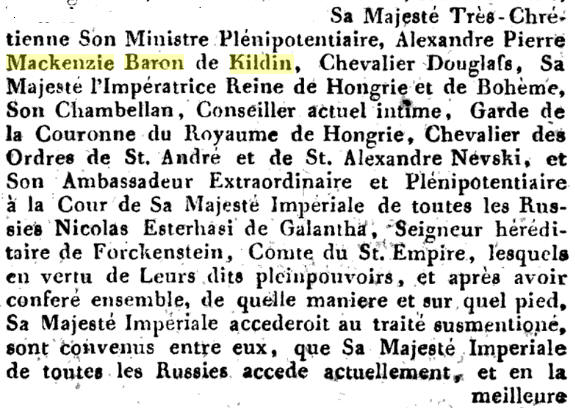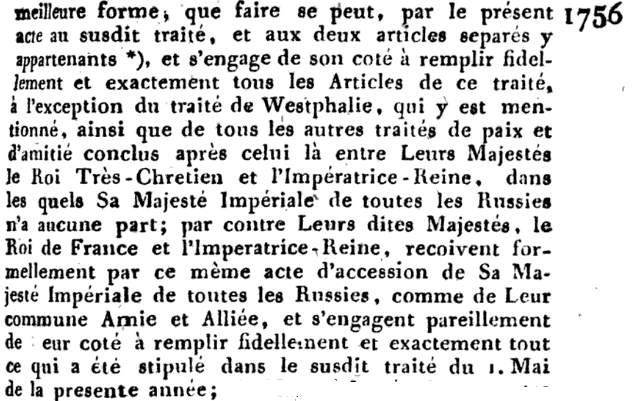|
| |
Alexandre-Pierre de Mackenzie-Douglas
|
|
|
|
This page is a stub.
You can help improve it.
Alexandre-Pierre de Mackensie-Douglas or Mackenzie-Douglas, baron de
Kildin(1) (1713-1765), also referred to as Alexandre
Pierre Mackenzie, baron de Kildin, chevalier Douglass, was a Jacobite in French service. According to the
memoirs of the Chevalier d'Eon, King Louis XV of France sent d'Eon and
Mackenzie-Douglas on a secret mission to Russia in order to meet Empress
Elizabeth (reigned 1741-1762) and to conspire with the pro-French
faction in Russia against the Habsburg monarchy.
The son of Colin MacKenzie of Kildin, a Captain in Fairburn's Regiment
at Sheriffmuir in 1715, he, and his elder brother Charles-Joseph Douglas(2), born in 1720, died
without posterity in 1788, were 'attached in their youth to the party of
Stuarts, followed in 1745 Prince Edward in Scotland and were taken
prisoner at the Battle of Culloden'.
He served as the official French chargé d'affaires in St Petersburg from
1755 to 1756 following the re-establishment of Franco-Russian diplomatic
relations, which had been broken off in 1748.
Mackensie-Douglas's tombstone was re-discovered in France in 2015. He
died 'without posterity'.



As the labyrinthine
Franco-Jacobite negotiations were carried on by a number
of actors, a
dramatis personae in
the shape
of a short
biographical sketch for each Jacobite negotiant is necessary.
The most conspicuous feature
of the principal
agents working for the French and the Jacobites was their
relative success, despite their lack
of cooperation. Their
only common denominator as negotiating parties was their
Jacobitism.
Of all the agents and
self-appointed envoys operating in 1757-59, the Chevalier
Alexander-Peter Mackenzie-Douglas deserves the place
of
primus inter pares.
The Mackenzies
of Kildin were the
only remaining Catholic branch within the clan. His father Colin
Mackenzie, a near relation
of the Earl
of Seaforth, had risen
in arms in 1715, and he himself was forced to flee England in
February 1747. During the last rising, Mackenzie-Douglas had
enjoyed the confidence
of the Lords Traquair
and Elibank, and that
of John Murray
of Broughton. Andrew
Lang claims he was a Jesuit, who had been a spy in the Dutch
service. Attaching himself to the retinue
of the Prince de
Conti, Mackenzie-Douglas soon became embroiled in the Secret du
Roi, Louis XV's private policy. In 1755, he was sent on a
diplomatic reconnaissance mission to St Petersburg. A second
mission, for which he was accorded full accreditation to the
Russian court, followed in due course. On this second trip,
Mackenzie-Douglas was accompanied by a secretary, the mysterious
Chevalier D'Eon dc Beaumont, whose alleged hermaphrodite gender
was one
of the great
curiosities
of the eighteenth
century. D'Eon was to become one
of the most successful
secret agents
of the French king. In
a memorial to James, in which he used the style
of Baron,
Mackenzie-Douglas claimed to have delivered a mortal blow to
Hanoverian influence 'dans tout le Nord'. His diplomatic
activities in 1756 certainly proved conducive to a Russian
accession to the alliance between France and Austria, and did
not go unnoticed by Sir Charles Hanburv-Williams, the British
resident at St Petersburg. In 1757-59, Mackenzie- Douglas' coded
correspondence apprised Charles
of developments at
Versailles. His principal function, however was that
of French
liaison-agent with the Jacobites.
Stuart Mss 378/79. Chevalier Alexander-Peter Mackenzie-Douglas
to James, 1 January 1758; BL Add. Ms 35481, ff. 4-7. Sir Charles
Hanbury-Williams to Robert Keith, 13 July 1756; Lang,
Pickle the Spy, 302;
McLynn,
The Jacobites, 136;
|
Addendum
In 1756, Charles-Geneviève-Louis-Auguste-André-Timothée d'Éon de
Beaumont joined the secret network of spies called the Secret du Roi,
(secret of the king), employed by King Louis XV without the knowledge of
the government. It sometimes promoted policies that contradicted
official policies and treaties. According to d'Éon's memoirs (although
there is no documentary evidence to support that account) the monarch
sent d'Éon with the Chevalier Douglas, Alexandre-Pierre de Mackensie-Douglas,
baron de Kildin, a Scottish Jacobite in French service, on a secret
mission to Russia in order to meet Empress Elizabeth and conspire with
the pro-French faction against the Habsburg monarchy. At that time the
English and French were at odds, and the English were attempting to deny
the French access to the Empress by allowing only women and children to
cross the border into Russia. D'Éon had to pass convincingly as a woman
or risk being executed by the English upon discovery. In the course of
this mission, d'Éon was disguised as the lady Lea de Beaumont, and
served as a maid of honour to the Empress. Eventually, Chevalier Douglas
became French ambassador to Russia, and d'Éon was secretary to the
embassy in Saint Petersburg from 1756 to 1760, serving Douglas and his
successor, the marquis de l'Hôpital. D'Éon's career in Russia is the
subject of one of Valentin Pikul's novels, Le chevalier d'Éon et la
guerre de Sept ans
Comments:
There is some similarity of stories relating to Jacobite involvement:
• Alexander, above
• Charles-Joseph Douglas, born in 1720, died without posterity in
1788, and Joseph Douglas, born in 1721, ambassador of France in Russia,
died without posterity, attached in their youth to the party of Stuarts,
followed in 1745 Prince Edward in Scotland and were taken prisoner at
the Battle of Culloden.
• Captain Charles Guillaume Douglas and Captain d'Hortore
Douglas, Capitaine dans le regiment de Languedoc and Capitaine
dans le regiment de Drummond ou Royal Ecossais (though not
necessarily respectively) were
prisoners of the '45
at Penrith. They are said to be brothers.
Notes:
1. In 1543 John Mackenzie acquired Kildins, part
of Lochbroom, to himself, and Elizabeth Grant, his wife, holding blench
for a penny, and confirmed in the same year by Queen Mary.
Alexander Mackenzie, who married Janet (? Isabella) daughter of
Alexander Mackenzie, V. of Gairloch, bought the lands of Ardross during
his father's lifetime, in 1644, formerly the property of Ross of Tolly,
and sold the lands of Pitglassie and Kildin. He was served. heir in 1662
; died in 1674, and was succeeded by his eldest son.
George Mackenzie of Kildin (a 1658) was the son of George Mackenzie, 2nd
Earl of Seaforth (b c1609, d 08.1651, Secretary of State for Scotland)
and (mcrt 22/23.01.1628) Barbara Forbes (b 17.01.1607, a 1666, dau of
Arthur Forbes, 10th Lord)
Colin MacKenzie of Kildin was a Captain in Fairburn's Regiment at
Sheriffmuir in 1715. He
a near relation
of the Earl
of Seaforth.
2. This might be
Charles Joseph de Douglas, K.S.L., Capt. Royal Scots,
Premier Conseiller du Corps de la Noblesse des Provinces de Bugey et
Valromey. Whilst their stories are similar, family details appear
to be different.
See also:
• Mackenzie-Douglas of
Glenbervie
• For more on the Douglas family in France, see our
France portal
|
Source
Sources for this article include:
Chevalier d'Eon, La Vie Militaire, politique, et privée de Mademoiselle
d'Éon, 1779
K.A. Papmehl; Freedom of Expression in Eighteenth Century Russia
Any contributions will be
gratefully accepted
|
|


